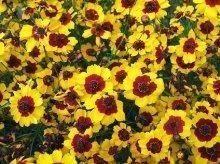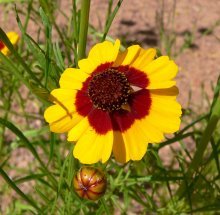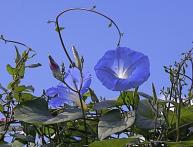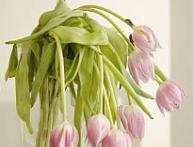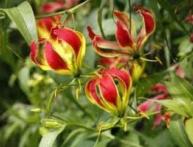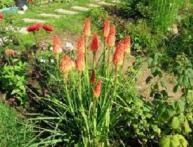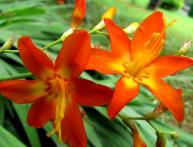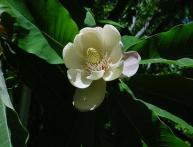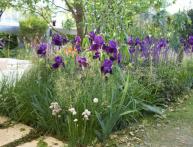Coreopsis tincture - a cheerful flower garden decoration

Gardeners fell in love with coreopsis for the sunny mood that it gives to the flower garden, for its joyful openwork lightness. The plant does not require complex care. However, when growing It is worth considering some features.
Content:
- Getting to know the view
- Advantages and differences
- Agricultural technology and cultivation features
- Application and beliefs
Getting to know the view
Coreopsis tincture is an annual from the numerous genus Coreopsis. Representative of the flora of the American continent, native to Canada, the USA, and northern Brazil. Often colonizes roadsides, flat meadows, field edges and wastelands. Here it is often called Calliopsis.
Among domestic gardeners it is known under the names Parisian Beauty, Lenok, Yellow Daisy, Maiden's Eyes. It grows on different types of soil; it performs best on dry, light sandy soils flavored with humus. Drought resistant. It grows and blooms more abundantly in sunny areas. Tolerates partial shading, but there are fewer flowers, they become slightly smaller.
More than 100 varieties have been cultivated. The height of an adult plant is from 20 cm to 1 m; dwarf forms up to 15 cm high have also been created. It forms a spacious herbaceous bush. The root is fibrous. The stem is erect, thin, branched. Narrow, heavily dissected leaves, tapering from the base to the apex.
Bright flowers are arranged singly or in groups of two or three, each on its own thin peduncle. There is no aroma.The inflorescence is a three- to five-centimeter basket. It consists of reed petals arranged in one row, with teeth and a yellow stripe along the outer edge. The central spot is dark, the size depends on varieties, the color of the middle is dark - red, burgundy, brown-red.
The seed capsule is flattened, shaped like an insect - a bug. It was she who gave the name to the plant: “coreopsis” from Greek - “bug-like”. Many small seeds ripen in the box.
Garden varieties are grown from seeds, usually from seedlings. It also reproduces by self-sowing. In such cases, it emerges before winter, forming low rosettes, or in early spring. The green mass grows quickly. Blooms from late June until frost.
Advantages and differences
The benefits of this plant are:
- unpretentious
- grows on any soil, especially well on dry sandy soils
- loves the sun, but can withstand some shade
- drought-resistant
- very decorative, forms light aerial thickets
- blooms long and profusely
- The coloring of the flowers is beautiful, evokes associations with sunlight and positive emotions
Distinctive features coreopsis dyestuffs is considered:
- the ability to develop and bloom in partial shade, which other species of the Coreopsis genus cannot boast of
- unlike most crops, prefers dry, depleted soils
Agricultural technology and cultivation features
Experienced and novice gardeners note the unpretentiousness of coreopsis. There is only one limiting (determining) factor - good illumination. To speed up flowering, annual coreopsis is grown in seedlings. Small seeds are sown in March or early April. Surface sowing, without embedding.
The container is covered with glass, film or transparent plastic. The greenhouse is ventilated periodically. Grown seedlings are thinned out, leaving 25-30 mm between them, or they are first planted according to a 2x2 cm pattern, and the second time - into separate pots. In May–June, after the end of night frosts, planted into the ground at a distance of at least 30 - 40 cm from each other.
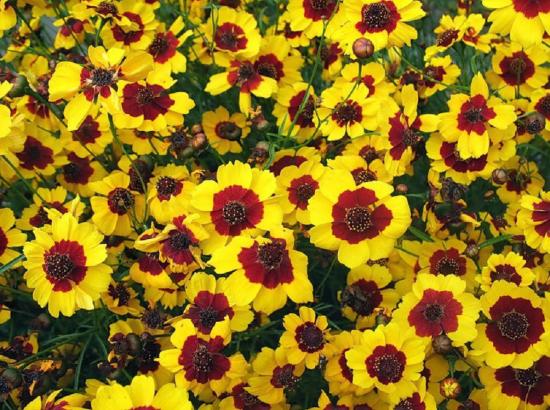
Direct sowing of seeds in open ground is carried out in late April - early May. Shoots and then seedlings are also thinned out. If seed pods remain on the plant and ripen, it can spread by self-seeding. In this case, the seedlings are cared for in the same way as in the case of direct sowing.
Planting in the ground and watering
Choose an open sunny place or an area where there is light shade in the afternoon, when the summer air is hottest. Sandy loam and loose dry soils are preferred. It perfectly develops depleted soils and sharply reduces flowering on heavy and fertile soils. Low-growing varieties are used in border plantings and for decorating terraces and balconies.
Tall ones are placed in separate groups - clumps, planted in the middle part of the flower beds, in the center or in the last high tier. Water moderately, in the absence of precipitation. The plant tolerates temporary drought more easily than excess moisture in the soil. After each watering and periodically between them, loosen the soil. Regularly deleted weeds.
Feeding, diseases and pests
Feeding begins two weeks after planting in open ground, when the bush takes root. Aqueous solutions of complex mineral fertilizers are used. Apply small portions, and only on poor soils. An excess leads to a reduction in flowering and active growth of greenery. In this case, flowering cannot be restored.
Video about planting and growing coreopsis:
Coreopsis is susceptible to leaf rust, viral, bacterial or fungal infections. If a disease is detected, as indicated by darkening of the leaves or the appearance of spots, the affected parts are immediately removed. The diseased plant and everything in the flower garden are treated with a fungicide to prevent the spread of infection.
If the rust has covered the entire bush and reached the top, the specimen will have to be sacrificed and removed, otherwise the entire flowerbed will die. More often than other insects coreopsis aphid attacks. To combat it, as well as caterpillars and beetle larvae, chemical plant protection products - insecticides - are used.
Chemicals are used strictly according to instructions, taking safety precautions.
Good to know:
- The cool, rainy beginning of summer delays the flowering period.
- Coreopsis blooms longer and more abundantly if faded inflorescences are periodically removed.
- Tall bushes need to be loosely tied to the support so that the plant is not broken by the wind.
- The flowers are suitable for bouquets and last a long time when cut.
- In flower beds it is combined with zinnia, gaillardia, and rudbeckia. Good in compositions with tall flowers with long, spiky inflorescences. Suitable for creating solo color accents.
Application and beliefs
Coreopsis inflorescences are used to make natural dyes of red shades and mahogany color. Used for dyeing yarn and textiles. To prepare paints, flowers are removed in the phase of half-opened buds and before they begin to wilt.
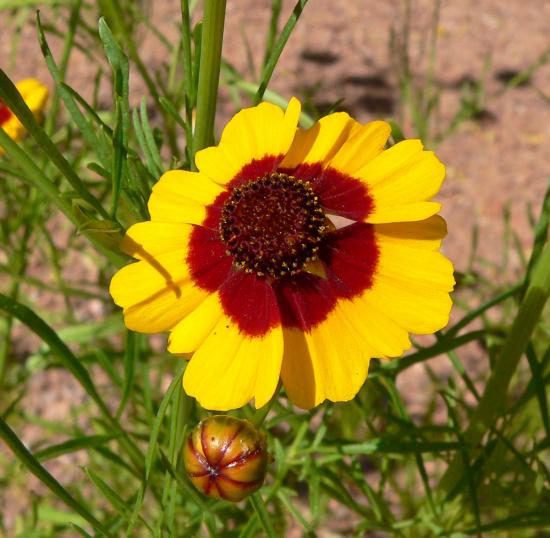
Collected in dry weather, after the dew has evaporated. Dry, spread out in one layer, in a dark, ventilated place. In my native land coreopsis There is a belief: if a woman expecting a child cooks and eats a dish made from a coreopsis bush, she will definitely have a daughter.
A delicate and very cheerful flower will decorate any garden. A bright place and lightly drained soil are all you need for a blooming sunny cloud of air to delight and improve your mood.

